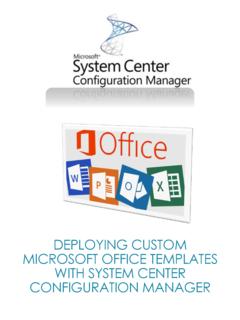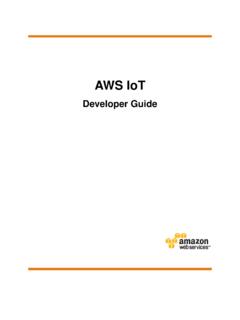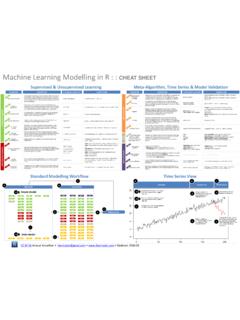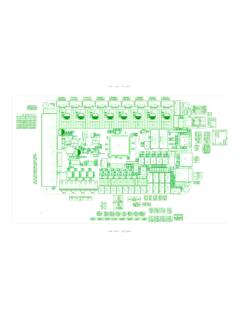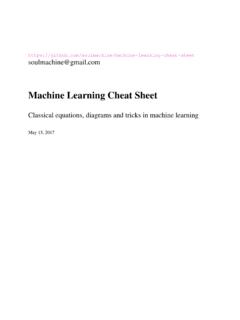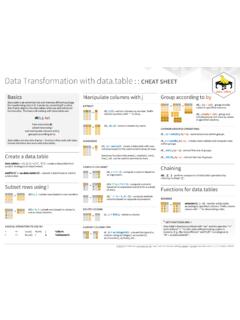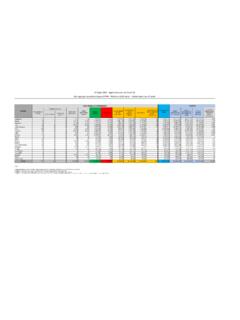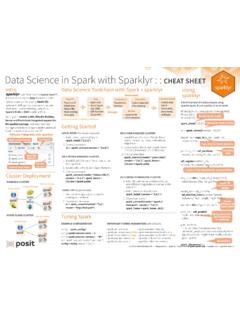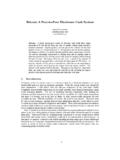Transcription of OWASP Top 10 - 2017 - GitHub
1 OWASP Top 10 -2017 The Ten Most Critical Web Application Security RisksThis work is licensed under aCreative Commons Attribution-ShareAlike International and LicenseCopyright 2003 2017 The OWASP FoundationThis document is released under the Creative Commons Attribution Share-Alike license. For any reuse or distribution, you must make it clear to others the license terms of this of ContentsAbout OWASPThe Open Web Application Security Project ( OWASP ) is an open community dedicated to enabling organizations to develop, purchase, and maintain applications and APIs that can be trusted. At OWASP , you'll find free and open: Application security tools and standards. Complete books on application security testing, secure code development, and secure code review. Presentations and videos. Cheat sheetson many common topics. Standard security controls and libraries. Local chapters worldwide. Cutting edge research. Extensive conferences worldwide. Mailing more at: OWASP tools, documents, videos, presentations, and chapters are free and open to anyone interested in improving application security.
2 We advocate approaching application security as a people, process, and technology problem, because the most effective approaches to application security require improvements in these is a new kind of organization. Our freedom from commercial pressures allows us to provide unbiased, practical, and cost-effective information about application security. OWASP is not affiliated with any technology company, although we support the informed use of commercial security technology. OWASP produces many types of materials in a collaborative, transparent, and open OWASP Foundation is the non-profit entity that ensures the project's long-term success. Almost everyone associated with OWASP is a volunteer, including the OWASP board, chapter leaders, project leaders, and project support innovative security research with grants and join us!TOCT able of ContentsTOC-About ..3RN-Release Notes ..4 Risk-Application Security Top 10 Application SecurityRisks :2017-Broken :2017-Sensitive Data :2017-XML External Entities (XXE).
3 10A5:2017-Broken Access Control ..11A6:2017-Security :2017-Cross-Site Scripting (XSS) ..13A8:2017-Insecure :2017-Using Components with KnownVulnerabilities ..15A10:2017-Insufficient Logging & +D-What s Next for +T-What s Next for Security +O-What s Next for +A-What s Next for Application Managers ..20+R-Note About +RF-Details About Risk +DAT-Methodology and + software is undermining our financial, healthcare, defense, energy, and other critical infrastructure. As our software becomes increasingly complex, and connected, the difficulty of achieving application security increases exponentially. The rapid pace of modern software development processes makes the most common risks essential to discover and resolve quickly and accurately. We can no longer afford to tolerate relatively simple security problems like those presented in this OWASP Top great deal of feedback was received during the creation of the OWASP Top 10 -2017, more than for any other equivalent OWASP effort.
4 This shows how much passion the community has for the OWASP Top 10, and thus how critical it is for OWASP to get the Top 10 right for the majority of use the original goal of the OWASP Top 10 project was simply to raise awareness amongst developers and managers, it has become thede facto application security this release, issues and recommendations are written concisely and in a testable way to assist with the adoption of the OWASP Top 10 in application security programs. We encourage large and high performing organizations to use the OWASP Application Security Verification Standard (ASVS)if a true standard is required, but for most, the OWASP Top 10 is a great start on the application security have written up a range of suggested next steps for different users of the OWASP Top 10, including What s Next for Developers, What s Next for Security Testers, What s Next for Organizations, which is suitable for CIOs and CISOs, and What s Next for Application Managers, which is suitable for application managers or anyone responsible for the lifecycle of the the long term, we encourage all software development teams and organizations to create an application security program that is compatible with your culture and technology.
5 These programs come in all shapes and sizes. Leverage your organization's existing strengths to measure and improve your application security program using the Software Assurance Maturity hope that the OWASP Top 10 is useful to your application security efforts. Please don't hesitate to contact OWASP with your questions, comments, and ideas at our GitHub project repository: can find the OWASP Top 10 project and translations here: , we wish to thank the founding leadership of the OWASP Top 10 project, Dave Wichers and Jeff Williams, for all their efforts, and believing in us to get this finished with the community's help. Thank you! Andrew van der Stock Brian Glas Neil Smithline Torsten GiglerProjectSponsorshipThanks to Autodeskfor sponsoring the OWASP Top 10 and individuals that have provided vulnerability prevalence data or other assistance are listed on the Acknowledgements to the OWASP Top 10 -2017! This major update adds several new issues, including two issues selected by the community -A8:2017-Insecure Deserializationand A10:2017-Insufficient Logging and Monitoring.
6 Two key differentiators from previous OWASP Top 10 releases are the substantial community feedback and extensive data assembled from dozens of organizations, possibly the largest amount of data ever assembled in the preparation of an application security standard. This provides us with confidence that the new OWASP Top 10 addresses the most impactful application security risks currently facing OWASP Top 10 -2017 is based primarily on 40+ data submissions from firms that specialize in application security and an industry survey that wascompleted by over 500 individuals. This data spans vulnerabilities gathered from hundreds of organizations and over 100,000 real-world applications and APIs. The Top 10 items are selected and prioritized according to this prevalence data, in combination with consensus estimates of exploitability, detectability, and primary aim of the OWASP Top 10 is to educate developers, designers, architects, managers, and organizations about the consequences of the most common and most important web application security weaknesses.
7 The Top 10 provides basic techniques to protect against these high risk problem areas, and provides guidance on where to go from for future activitiesDon't stop at 10. There are hundreds of issues that could affect the overall security of a web application as discussed in the OWASP Developer's Guideand the OWASP Cheat Sheet Series. These are essential reading for anyone developing web applications and APIs. Guidance on how to effectively find vulnerabilities in web applications and APIs is provided in the OWASP Testing The OWASP Top 10 will continue to change. Even without changing a single line of your application's code, you may become vulnerable as new flaws are discovered and attack methods are refined. Please review the advice at the end of the Top 10 in What's Next For Developers, Security Testers, Organizations, and Application Managers for more positive. When you're ready to stop chasing vulnerabilities and focus on establishing strong application security controls, the OWASP Proactive Controls project provides a starting point to help developers build security into their application and the OWASP Application Security Verification Standard (ASVS)is a guide for organizations and application reviewers on what to tools wisely.
8 Security vulnerabilities can be quite complex and deeply buried in code. In many cases, the most cost-effective approach for finding and eliminating these weaknesses is human experts armed with advanced tools. Relying on tools alone provides a false sense of security and is not left, right, and everywhere. Focus on making security an integral part of your culture throughout your development organization. Find out more in the OWASP Software Assurance Maturity Model (SAMM).AttributionWe'd like to thank the organizations that contributed their vulnerability data to support the 2017 update. We received more than 40 responses to the call for the first time, all the data contributed to a Top 10 release, and the full list of contributors is publicly available. We believe this is one of the larger, more diverse collections of vulnerability data ever publicly there are more contributors than space here, we have created a dedicated page to recognize the contributions made.
9 We wish to give heartfelt thanks to these organizations for being willing to be on the front lines by publicly sharing vulnerability data from their efforts. We hope this will continue to grow and encourage more organizations to do the same and possibly be seen as one of the key milestones of evidence-based security. The OWASP Top 10 would not be possible without these amazing big thank you to the more than 500 individuals who took the time to complete the industry ranked survey. Your voice helped determine two new additions to the Top 10. The additional comments, notes of encouragement, andcriticisms were all appreciated. We know your time is valuable and we wanted to say would like to thank those individuals who have contributed significant constructive comments and time reviewing this update to the Top 10. As much as possible, we have listed them on the Acknowledgements finally, we'd like to thank in advance all the translators out there who will translate this release of the Top 10 into numerous different languages, helping to make the OWASP Top 10 more accessible to the entire changed from 2013 to 2017?
10 Change has accelerated over the last four years, and the OWASP Top 10 needed to change. We've completely refactored the OWASP Top 10, revamped the methodology, utilized a new data call process, worked with the community, re-ordered our risks, re-written each risk from the ground up, and added references to frameworks and languages that are now commonly the last few years, the fundamental technology and architecture of applications has changed significantly: Microserviceswritten in and Spring Boot are replacing traditional monolithic applications. Microservicescome with their own security challenges including establishing trust between microservices, containers, secret management, etc. Old code never expected to be accessible from the Internet is now sitting behind an API or RESTful web service to be consumed by Single PageApplications (SPAs) and mobile applications. Architectural assumptions by the code, such as trusted callers, are no longer valid.
